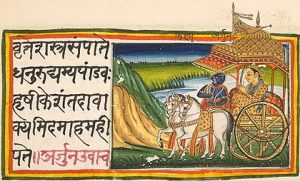Difference between revisions of "Language/Sanskrit/Grammar/How-to-Use-Be"
m (Quick edit) |
m (Quick edit) |
||
| Line 59: | Line 59: | ||
|description=In this lesson, we will learn how to use the verb "be" in Sanskrit. We will look at the different forms of the verb "be" and how they are used in sentences. We will also look at some examples of sentences using the verb "be". | |description=In this lesson, we will learn how to use the verb "be" in Sanskrit. We will look at the different forms of the verb "be" and how they are used in sentences. We will also look at some examples of sentences using the verb "be". | ||
}} | }} | ||
==Related Lessons== | |||
* [[Language/Sanskrit/Grammar/Negation|Negation]] | |||
* [[Language/Sanskrit/Grammar/Gender|Gender]] | |||
* [[Language/Sanskrit/Grammar/Pronouns|Pronouns]] | |||
* [[Language/Sanskrit/Grammar/Future-Tense|Future Tense]] | |||
* [[Language/Sanskrit/Grammar/Plurals|Plurals]] | |||
* [[Language/Sanskrit/Grammar/How-to-Use-Have|How to Use Have]] | |||
* [[Language/Sanskrit/Grammar/Give-your-Opinion|Give your Opinion]] | |||
* [[Language/Sanskrit/Grammar/Conditional-Mood|Conditional Mood]] | |||
* [[Language/Sanskrit/Grammar/Questions|Questions]] | |||
{{Sanskrit-Page-Bottom}} | {{Sanskrit-Page-Bottom}} | ||
Revision as of 00:33, 2 March 2023
Hi Sanskrit learners! 😊
In this lesson, we will learn how to use the verb "be" in Sanskrit. This is an intermediate level lesson, so if you are a beginner, you may want to review some of the basics of Sanskrit grammar before continuing. We will look at the different forms of the verb "be" and how they are used in sentences. We will also look at some examples of sentences using the verb "be".
Forms of the Verb "Be"
The verb "be" in Sanskrit has three forms: अस्ति (asti), अस्ति (asti), and अस्ति (asti). The first form, अस्ति (asti), is used for present tense. The second form, अस्ति (asti), is used for past tense. The third form, अस्ति (asti), is used for future tense.
Present Tense
The present tense of the verb "be" is used to describe something that is happening now or something that is true in the present moment. For example:
- Person 1: मैं अस्ति (Mām asti) (I am)
- Person 2: तू अस्ति (Tū asti) (You are)
Past Tense
The past tense of the verb "be" is used to describe something that happened in the past. For example:
- Person 1: मैं अस्ति (Mām asti) (I was)
- Person 2: तू अस्ति (Tū asti) (You were)
Future Tense
The future tense of the verb "be" is used to describe something that will happen in the future. For example:
- Person 1: मैं अस्ति (Mām asti) (I will be)
- Person 2: तू अस्ति (Tū asti) (You will be)
Examples
Here are some examples of sentences using the verb "be" in Sanskrit:
| Sanskrit | Pronunciation | English Translation |
|---|---|---|
| मैं अस्ति | Mām asti | I am |
| तू अस्ति | Tū asti | You are |
| वह अस्ति | Vah asti | He/She is |
| हम अस्ति | Ham asti | We are |
| तुम अस्ति | Tum asti | You (plural) are |
| वे अस्ति | Ve asti | They are |
To improve your Sanskrit Grammar, you can also use the Polyglot Club website. Find native speakers and ask them any questions!
Conclusion
In this lesson, we have learned how to use the verb "be" in Sanskrit. We have looked at the different forms of the verb "be" and how they are used in sentences. We have also seen some examples of sentences using the verb "be".
We hope that this lesson has been helpful and that you now have a better understanding of how to use the verb "be" in Sanskrit.
➡ If you have any questions, please ask them in the comments section below.
➡ Feel free to edit this wiki page if you think it can be improved. 😎
Related Lessons
- Negation
- Gender
- Pronouns
- Future Tense
- Plurals
- How to Use Have
- Give your Opinion
- Conditional Mood
- Questions
